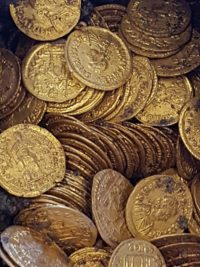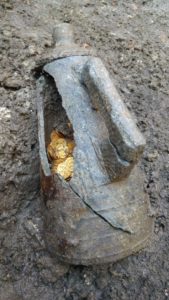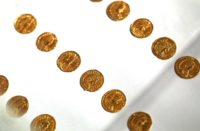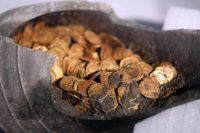 A unique hoard of gold coins from the late Imperial era has been discovered in downtown Como, Lombardy, northern Italy. The coins were unearthed on Wednesday, September 5th, in an archaeological excavation at the site of the former Cressoni Theater which is being redeveloped. They were contained in a soapstone amphora which has a big chunk missing so the pile of glimmering coin within was clearly visible at first sight.
A unique hoard of gold coins from the late Imperial era has been discovered in downtown Como, Lombardy, northern Italy. The coins were unearthed on Wednesday, September 5th, in an archaeological excavation at the site of the former Cressoni Theater which is being redeveloped. They were contained in a soapstone amphora which has a big chunk missing so the pile of glimmering coin within was clearly visible at first sight.
 The amphora was transported to the conservation laboratory of the regional archaeological Superintendency where it is currently being excavated. The coins were tightly packed in little stacks. It will take a long time to complete the job because the contents have to be removed one piece at a time paying close attention to stratigraphy. Layer analysis will be key to determining if the coins were deposited in the same era or over a period of time.
The amphora was transported to the conservation laboratory of the regional archaeological Superintendency where it is currently being excavated. The coins were tightly packed in little stacks. It will take a long time to complete the job because the contents have to be removed one piece at a time paying close attention to stratigraphy. Layer analysis will be key to determining if the coins were deposited in the same era or over a period of time.
 So far 27 gold coins have been recovered and examined. They all date to the 5th century. Coins from this period are very rare because currency didn’t flow as efficiently through the imperial economic system. The quantity and quality of the coins are exceptional, especially for the late empire. The 27 were minted in the reigns of the Emperors Honorius (r. 384–423), Valentinian III (r. 425-455), Leo I the Thracian (r. 457-474) and his short-lived co-emperor Libius Severus (r. 461-465).
So far 27 gold coins have been recovered and examined. They all date to the 5th century. Coins from this period are very rare because currency didn’t flow as efficiently through the imperial economic system. The quantity and quality of the coins are exceptional, especially for the late empire. The 27 were minted in the reigns of the Emperors Honorius (r. 384–423), Valentinian III (r. 425-455), Leo I the Thracian (r. 457-474) and his short-lived co-emperor Libius Severus (r. 461-465).
No such hoard has even been unearthed in northern Italy before. The gold is in an excellent state of preservation making the images and engravings on the coins and thus the engraver, year and sponsor relatively easily to discern.
 There are an estimated 300 coins in the amphora (which is itself of major significance because it is of a previously unknown design), and not just coins. Archaeologists have reason to believe there may be other precious objects deep in the amphora hidden amidst the dense coin clusters, small pieces like pins, figurines and ingots. One gold bar has already been found and two other objects yet to be identified.
There are an estimated 300 coins in the amphora (which is itself of major significance because it is of a previously unknown design), and not just coins. Archaeologists have reason to believe there may be other precious objects deep in the amphora hidden amidst the dense coin clusters, small pieces like pins, figurines and ingots. One gold bar has already been found and two other objects yet to be identified.
Whoever placed the jar in that place “buried it in such a way that in case of danger they could go and retrieve it,” said Maria Grazia Facchinetti, a numismatist — or expert in rare coins — at a Monday press conference.
“They were stacked in rolls similar to those seen in the bank today,” she said, adding the coins have engravings about emperors Honorius (r. 384–423), Valentinian III, Leon I, Antonio, and Libio Severo “so they don’t go beyond 474 AD.”
“All of this makes us think that the owner is not a private subject, rather it could be a public bank or deposit,” Facchinetti added.
The find site is just a few feet away from the forum of the Roman city where merchants, banks and temples would have done brisk cash business. It was also an elite residential neighborhood, however, so it’s not out of the question that a private individual rolled up his own wealth.